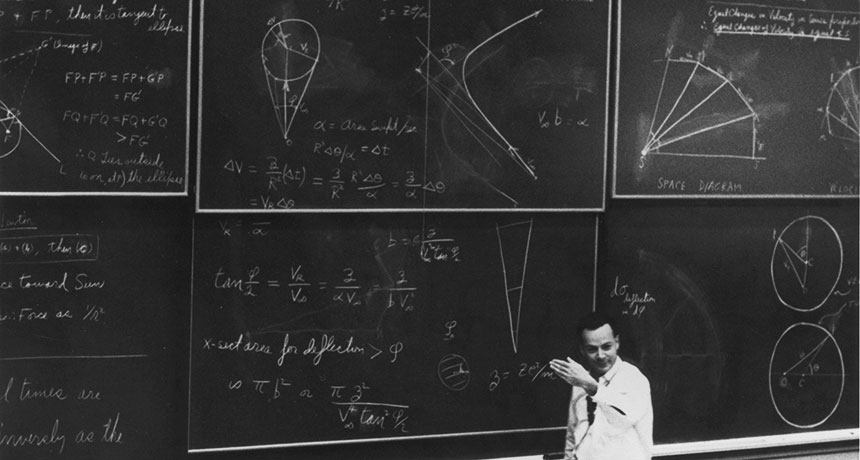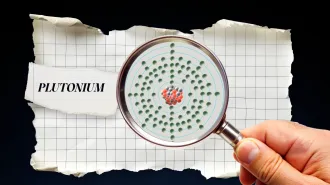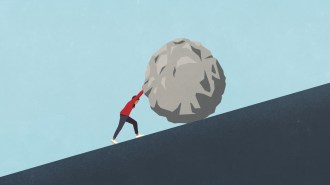A celebration of curiosity for Feynman’s 100th birthday
Famed Nobel laureate pursued nature’s secrets with a disdain for expert authority

Richard Feynman was never satisfied to simply know the answer to a problem; he had to puzzle the problem out for himself.
U.S. Department of Energy, WikiCommons
- More than 2 years ago
Richard Feynman was a curious character.
He advertised as much in the subtitle of his autobiography, Surely You’re Joking, Mr. Feynman!: Adventures of a Curious Character. Everybody knew that, in many respects, Feynman was an oddball.
But he was curious in every other sense of the word as well. His curiosity about nature, about how the world works, led to a Nobel Prize in physics and a legendary reputation, both among physicists and the public at large.
Feynman was born 100 years ago May 11. It’s an anniversary inspiring much celebration in the physics world. Feynman was one of the last great physicist celebrities, universally acknowledged as a genius who stood out even from other geniuses.
In 1997 I interviewed Nobel laureate Hans Bethe, a Cornell University physicist who worked with Feynman during World War II on the atomic bomb project at Los Alamos (and later on the Cornell faculty). “Normal” geniuses, Bethe said, did things much better than other people but you could figure out how they did it. And then there were magicians. “Feynman was a magician. I could not imagine how he got his ideas,” Bethe told me. “He was a phenomenon. Feynman certainly was the most original physicist I have seen in my life, and I have seen lots of them.”
Apart from his brilliance as a physicist, Feynman was also known for his skill at playing the bongo drums and cracking safes. Public acclaim came after he served on the presidential commission investigating the explosion of the space shuttle Challenger. In a dramatic moment during a hearing about that disaster, he dipped material from an O-ring (a crucial seal on the shuttle’s rockets) into icy water, demonstrating that an O-ring would not have remained flexible at the launch-time temperature.
His autobiography had already become a best seller, so Feynman was well-known when he died in February 1988.
When I heard of Feynman’s death, I called John Wheeler, Feynman’s doctoral adviser at Princeton University before World War II.
“I felt very lucky to have him as my graduate student,” said Wheeler, who died in 2008. “There was an immense vitality about Feynman. He was interested in all kinds of problems.”
Feynman’s curiosity was not satisfied merely by being told the solution to a problem, though.
“If you said you had the answer to something, he wouldn’t let you tell it,” Wheeler said. “He had to stand on his head and pace up and down and figure out the answer for himself. It was his way of keeping the ability to make headway into brand new frontiers.”
Feynman found fascination in all sorts of things, some profound, some trivial. In his autobiography, he revealed that he spent a lot of time analyzing ant trails. He sometimes entertained Wheeler’s children by tossing tin cans into the air and then explaining how the way the can turned revealed whether the contents were solid or liquid.
Curiosity of that type was instrumental in the work that led to his Nobel Prize. While eating in the Cornell cafeteria, Feynman noticed someone tossing a plate, kind of like a Frisbee. As the plate flew by, Feynman noticed that the Cornell medallion on the plate was rotating more rapidly than the plate was wobbling. He performed some calculations and showed that the medallion’s rotation rate should be precisely twice the rate of the wobbling. He then perceived an analogy to a problem he had been investigating relating to the motion of electrons. The wobbling plate turned out to provide the clue he needed to develop a new version of the theory of quantum electrodynamics.
“The whole business that I got the Nobel Prize for came from that piddling around with the wobbling plate,” he wrote in his autobiography.
It was not curiosity alone that made Feynman a legend. His approach to physics and life incorporated a willful disdain for authority. He regularly disregarded bureaucratic rules, ignored expert opinion and was willing to fearlessly criticize the most eminent of other scientists.
During his time at Los Alamos, for instance, he encountered Niels Bohr, the foremost atomic physicist of the era. Other physicists held Bohr in awe. “Even to the big shot guys,” Feynman recalled, “Bohr was a great god.” During a meeting in which the “big shots” deferred to Bohr, Feynman kept pestering him with questions. Before the next meeting, Bohr called Feynman in to talk without the big shots. Bohr’s son (and assistant) later explained why. “He’s the only guy who’s not afraid of me, and will say when I’ve got a crazy idea,” Niels had said to his son. “So next time when we want to discuss ideas, we’re not going to be able to do it with these guys who say everything is yes, yes, Dr. Bohr. Get that guy and we’ll talk with him first.”
Feynman knew that he sometimes made mistakes. Once he foolishly even read some papers by experts that turned out to be wrong, retarding his work on understanding the form of radioactivity known as beta decay. He vowed never to make the mistake of listening to “experts” again.
“Of course,” he ended one chapter of his autobiography, “you only live one life, and you make all your mistakes, and learn what not to do, and that’s the end of you.”
Follow me on Twitter: @tom_siegfried







